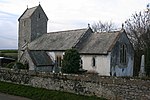Nash Point

Nash Point (Welsh: Trwyn yr As) is a headland and beach in the Monknash Coast of the Vale of Glamorgan in south Wales, about a mile from Marcross. It is a popular location for ramblers and hiking along the cliffs to Llantwit Major beach. The lighthouse meadow is a Site of Special Scientific Interest, containing rare plants such as the tuberous thistle, and other wildlife such as choughs can be seen. Parts of the section of the Glamorgan Heritage Coast where the lighthouse stands consists of "cliffs of Lias limestone interbedded with softer erodible material" and has been identified as potentially at risk from erosion and flooding. Many fossils, including ammonites and gryphaea are to be found there. Marcross Brook passes through the cliffs and an Iron Age hillfort, usually called Nash Point Camp, stands on the north side of the brook, although its remains have been largely eroded by the sea. Round barrows are also to be found nearby. A study of the rocks shows that they exemplify "a 12,000 year old sequence of tufa, scree and slope deposits containing abundant fossil snails", while the Nash Bank offshore is formed by "Jurassic mudstones overlain by bands of sand and gravel".
Excerpt from the Wikipedia article Nash Point (License: CC BY-SA 3.0, Authors, Images).Nash Point
Geographical coordinates (GPS) Address Nearby Places Show on map
Geographical coordinates (GPS)
| Latitude | Longitude |
|---|---|
| N 51.4038 ° | E -3.5615 ° |
Address
CF61 1ZF , St. Donats
Wales, United Kingdom
Open on Google Maps







